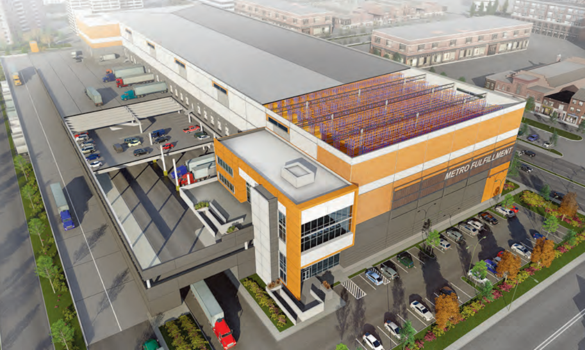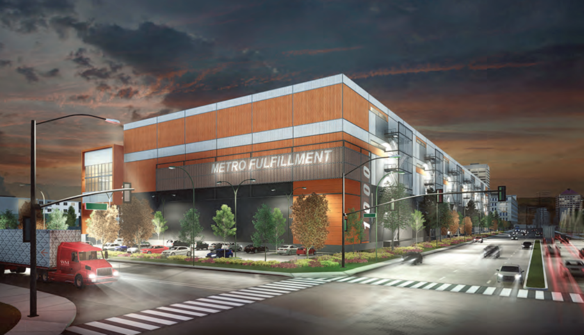The Perfect Storm or Rising Sea Levels?
The Future of Industrial Warehousing
December 11th, 2020
Let me tell you a story.
This isn’t the one with a daring hero or an epic journey against insurmountable odds. Nor is it one with a happy ending. In fact, it has no ending at all, as this tale continues to unfold and write itself in real-time.
Whereby most accounts are told from a personal or psychological perspective, this one simply tells of the various forces at-large that are at play, and how their effects are manifesting in the creation of a type of property that has yet to be proven and adopted by the mainstream in North America – and even – the greater world.
What’s this, say you?
It is the futuristic, feat of engineering that captures the imagination and carries us off into a world with drones and flying cars a la Blade Runner. It’s a concept so foreign and complex in execution that it would send many developers and contractors running for the hills. Strangely enough, it is also one that has its history in Asia for well over two decades; where builders have, as a response to necessity, cast aside notions of what can or can’t be done.

The reason it has yet to become a staple of commercial properties stateside is simply for pragmatic reasons. There was never a real need to go through all of the zoning, design, architectural, and financial hurdles that dramatically amplify risk and eat into pre-existing, easy, and healthy margins (analysts and underwriters beware).
As we enter into 2021, we are talking about a product in an asset class that is not only ‘on fire’ as it is so popularly described, but rather, it has become multi-dimensional in its forms and applications.
It has become the ‘legs’ for dozens of industries to operate via social distancing and same-day deliveries.
It has become the carrier of our food, the creator of our streaming content, the laboratory for our medicines, as well as the manufacturer of our goods.
The asset class is industrial.
And the property is multi-storey industrial warehousing.
(And yes, it’s coming to Canada soon… actually, it is under construction, as we will highlight in one of our upcoming issues…)
The Perfect Storm or Rising Sea Levels?
As any builder or architect will know, ‘form follows function’… but is function feasible?
So let’s examine some of the issues and challenges developers and builders must face before multi-storey industrial warehouses become widely accepted by both the capital markets and mainstream Users.
Developers’ ability to underwrite still uncertain
The fact remains that multi-storey warehouses require much more investment up front, with little security or knowledge that a Tenant is waiting for them on the other side. Not only that, but there are considerable hoops to jump through throughout the process, as well as a longer time horizon during construction.
Meanwhile, rents are not entirely supporting the profitable construction of said facilities in many markets. But there are cases where it could work…
Take this example from Ware Malcomb, whereby ”a minimum parcel size of 9 acres would accommodate a three-level building totaling 424,000 square feet, including truck ramps but excluding surface parking. A typical estimated cost for such a structure would be approximately $135 per square foot for the shell building and $23 per square foot for the parking deck. As this new building type finds market acceptance, the next natural evolution may become a new way of looking at the rent structure. These specialized buildings may ultimately command a rent premium that could eventually evolve from renting space on a square foot basis to a cubic foot basis, not unlike the rent structure for cold storage and freezer buildings.”

Source: Ware Malcomb via NAIOP
Land values and rental rates increasing sharply and quickly
As land values and rental rates in the GTA continue to rise sharply, developers move into range of being able to meet their criteria to ‘green light’ a project like this. That being said, without historical trends being established, this adds another layer of risk. It is not a widely-held belief that rents will dip below to their earlier levels, however, the rents required for a multi-storey facility are already at a significant premium to current rates. This means that, as a whole, developers are leaning on the market – as well as its largest, credit-worthy, and space-hungry Tenants – to come through.
Space efficiency per storey is lower than traditional layout
This has already been noted, however, the coverage of a multi-storey facility must be factored in to the already expensive costs to acquire land and develop it. With the need for ramps, as well as other structural components, the numbers keep going up, margins are compressed, and the room for error diminishes.
Needs to satisfy HABU principles of investors, developers, and landlords, while being approved by municipalities
When looking at the various options available to a developer with prime real estate within the City of Toronto, most don’t opt for cutting-edge, speculative development. One look at the skyline will tell you what the bread-and-butter has been for the past several decades. That leads one to believe that a longer-term vision and confidence in the future state of the industrial market is what is being executed on. These facilities will certainly bring profits and strategic gains, however, it is not likely that many will be straying from residential high-rise towers until the concept has been proven, and proven again.
According to Ware Malcomb, “each site and municipality poses its own unique set of challenges. In urban cores with higher land costs and limited truck access, buildings will need to be more than two or three stories tall, with high-speed freight elevators, to produce the needed return on investment. City leaders will need to be educated to address specific zoning height limitations in exchange for the benefits of increased job creation and, in some cases, sales tax generation.”
Needs to be fire-proof in most cities; built from concrete and heavy steel
According to Prologis, “under new building codes, if a structure is more than three stories in height it is typically required to have a one-hour fire rating, meaning the structure will resist exposure to fire for one hour. Because of this regulation, owners and developers either have to frame the structural support with heavy steel and fireproof the facility or build the structure from concrete. Each of these scenarios adds significant cost to the overall construction budget. Another expense with multistory structures is that every square foot is not leasable. Elevators, equipment rooms, stair towers, etc. require dedicated space. At most, about 75 percent of the total floor area is rentable.”
May need to rely on redevelopment or creative site planning with infill locations
With few untouched sites within the City, it may take a redevelopment or creative site planning in order to get a project such as this going. It is certainly possible, however, it wouldn’t be called ‘low-hanging fruit.’
Lack of Tenants backing spec developments underway in the United States
So far, most of the multi-storey facilities constructed or under construction in the United States are not fully-Tenanted, nor pre-leased like their single-storey industrial counterparts.
Potential issues with multiple Tenants in a facility
While this has not been reported as an issue as of yet, it is plausible that multiple Tenants within a single facility, especially competitors, may have issues relating to conflicting operations or privacy.

Source: Ware Malcomb via NAIOP
You Can Build It… But Will They Come???
While the industry has yet to perfect the construction process, get buy-in from the broader investment community or mainstream Users, or justify its underwriting of such projects through current rental rates in the GTA… those things may quickly change.
As consumers continue to spend money online and pay for same-day deliveries, then e-commerce providers will (and do) have the cash necessary to pay for cutting-edge facilities in prime locations. It is simply a cost of doing business. Not to mention that, despite the associated price tag, real estate costs make up much less than what is being spent on logistics and transportation. And as land continues to grow more and more scarce… and with rental rates creeping ever upward… a forward-looking User will see the long-term value, the strategic advantage, and the return on investment.
Conclusion
The concept of a multi-storey industrial warehouse is one of creativity, imagination, and ingenuity. Its existence and operation within our society will be one of necessity and financial incentive… either that or an initiative carried out by a progressive and risk-taking developer. So far, the Greater Toronto Area does not have a backer, but, given the forces at play, the Region would likely make a great candidate.
Extremely dense pockets of the urban core may be well served by these futuristic buildings and their ability to connect with consumers. The only roadblocks right now are economics and experience. With few understanding the former, and even fewer possessing the latter, it may take a bold move to get the ball rolling. However, once successfully completed, the pioneers should inspire the early majority. From there, it will not be unreasonable to see them spaced throughout the City of Toronto.
Next week, we will examine the feasibility of constructing multi-storey industrial warehouses in North America.
In the meantime, if you would like a confidential consultation or a complimentary opinion of value of your property please give us a call.
Until next week…
Goran Brelih and his team have been servicing Investors and Occupiers of Industrial properties in Toronto Central and Toronto North markets for the past 25 years.
Goran Brelih is a Senior Vice President for Cushman & Wakefield ULC in the Greater Toronto Area.
Over the past 27 years, he has been involved in the lease or sale of approximately 25.7 million square feet of industrial space, valued in excess of $1.6 billion dollars while averaging between 40 and 50 transactions per year and achieving the highest level of sales, from the President’s Round Table to Top Ten in GTA and the National Top Ten.
Goran is currently serving as Immediate Past President of the SIOR ‐ Society of Industrial and Office Realtors, Central Canadian Chapter.
Specialties:
Industrial Real Estate Sales and Leasing, Investment Sales, Design-Build and Land Development
About Cushman & Wakefield ULC.
Cushman & Wakefield is a leading global real estate services firm that delivers exceptional value by putting ideas into action for real estate occupiers and owners. Cushman & Wakefield is among the largest real estate services firms with 48,000 employees in approximately 400 offices and 70 countries.
In 2017, the firm had revenue of $6.9 billion across core services of property, facilities and project management, leasing, capital markets, advisory, and other services. To learn more, visit www.cushmanwakefield.com or follow @CushWake on Twitter.
For more information on GTA Industrial Real Estate Market or to discuss how they can assist you with your real estate needs please contact Goran at 416-756-5456, email at goran.brelih@cushwake.com, or visit www.goranbrelih.com.
Connect with Me Here! – Goran Brelih’s Linkedin Profile: https://ca.linkedin.com/in/goranbrelih
Goran Brelih, SIOR
Senior Vice President, Broker
Cushman & Wakefield ULC, Brokerage.
www.cushmanwakefield.com
Immediate Past President, SIOR – Central Canada Chapter
www.siorccc.org
Office: 416-756-5456
Mobile: 416-458-4264
Mail: goran.brelih@cushwake.com
Website: www.goranbrelih.com

Newsletter
Join our mailing list to receive the latest news and updates from our team.

